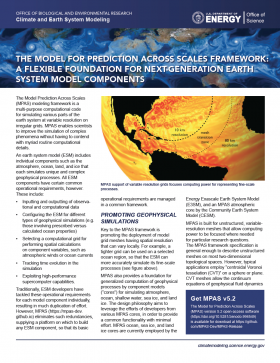Model for Prediction Across Scales (MPAS)
The Model for Prediction Across Scales (MPAS) modeling framework is a multi-purpose computational code for simulating various parts of the Earth system at variable resolution on irregular grids. MPAS enables scientists to improve the simulation of complex phenomena without having to contend with myriad routine computational details.
An Earth system model (ESM) includes individual components such as the atmosphere, ocean, land, and ice that each simulate unique and complex geophysical processes. All ESM components have certain common operational requirements, however. These include:
- Inputting and outputting of observational and computational data
- Configuring the ESM for different types of geophysical simulations (e.g. those involving prescribed versus calculated ocean properties)
- Selecting a computational grid for performing spatial calculations on component variables, such as atmospheric winds or ocean currents
- Tracking time evolution in the simulation
- Exploiting high-performance supercomputer capabilities
Traditionally, ESM developers have tackled these operational requirements for each model component individually, resulting in much duplication of effort. However, MPAS eliminates such redundancies, supplying a platform on which to build any ESM component, so that its basic operational requirements are managed in a common framework.

